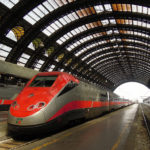 The 350km High Speed 2 project from London to the north-west of England has been beset with problems and cost over-runs since it was officially kicked off in 2017 to the extent that various public figures suggest that losses should be cut and the project kicked into the long grass.
The 350km High Speed 2 project from London to the north-west of England has been beset with problems and cost over-runs since it was officially kicked off in 2017 to the extent that various public figures suggest that losses should be cut and the project kicked into the long grass.
With the cost ceiling seemingly growing all the time, it’s a temptation that is understandable, but new research provides a timely reminder as to the benefit of high speed rail links between major cities.
The paper highlights the growing number of routes across Europe that are faster to travel by train than by plane, both do to the journey time itself, but more specifically by the reduced security checks and the fact that you typically disembark in the city center itself rather than its outskirts. What’s more, you can often continue to work and access the internet while you travel.
Mobile talent
The research suggests that high-speed rail services facilitated long-distance commuting among high earning professionals in Italy, which in turn resulted in greater upward mobility for the most talented individuals, not least to board level positions.
The research examines this during the gradual introduction of high-speed train services in Italy, and aims to see whether this introduction increased the pool of potential directors firms could recruit from, and then the general quality of boards overall during that timeframe.
The researchers track 75,000 firms of varying sizes, who between them have 209,000 directors. The firms are tracked between 2005-2016 to explore the makeup of the boards, and the overall quality of the firms.
The data suggests that high-speed rail has a significant impact on the quality of boards firms are able to create. For instance, there are around 51,000 directors serving on boards in Milan, and 11,000 in Bologna, and the high-speed train link between the two cities reduced the firm-board mismatch by 2.4% of standard deviation.
This improvement appears primarily to come from firms that are located close to the high-speed rail station, with the phenomenon weakening the further the firm is located away from the station. The researchers believe this underlines the importance of travel time, not only between cities but within them.
The fast track
The researchers suggest that the introduction of the train line meant that there was a greater proportion of directors in Milan who were either born in Bologna or had director-experience in the city. What’s more, the increase in directors from the two cities appears to rise in direct correlation with the decline in directors from other cities in the north of Italy.
There also appears to be benefits in terms of the diversity of boards, with firms located on the train line generally younger and more diverse than those located elsewhere, although it must be said that there seems little impact on the gender diversity of boards. The authors suggest this is because younger people are happier commuting longer distances, and the societal pressures placed on females in the home make such long commutes difficult.
The researchers believe that the construction of the high-speed train line has had a number of effects on the labor market in the region. For instance, they argue that by deepening the talent pool available to firms, the quality of boards has risen. They also believe that the number of board appointments per director has also risen as a result of the greater connectivity, with this having significant possible impact on collaboration between firms.
As is so often the case, this greater connectivity appears to benefit the most productive firms more than their less productive peers, but the researchers hope that their work sheds light on the important impact such connectivity between cities can bring to the economic vibrancy of a region. They suggest there is clear correlation between connectivity and quality of board hire, which in turn is strongly linked to the financial performance of those firms.
They hope that it provides a nuanced look at the value high-speed rail links can provide, as many examinations look at worker mobility in the whole rather than at specific sections of the workforce. By raising human capital at the executive level however, they believe such investments quickly pay off.